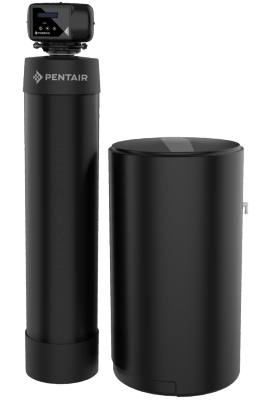Stop Wasting Water and Money. FIND A LOCAL PRO
Do You Have Well Water?
According to the Environmental Protection Agency (EPA), most homes in the United States get their water from the local water department. When you receive water from the city, officials treat your water at a plant and pump it to your home in underground piping.
Homeowners that live far from the nearest municipality often choose to install a well near their home and source their water directly from the private well. Currently, more than 13 million households nationwide rely on well water, according to the EPA.
Well Water Vs. City Water
If you’re unsure what kind of water (well water or “city” water) you have in your home, ask yourself these questions:
Is your address within the city limits?
If you reside within a city, chances are your water comes from the local water department. If you live in a rural area, your water may come from a well.

Do you pay a water bill?
When your water comes from the local water department, you’ll regularly pay a water bill, perhaps once a month, to that organization. Homeowners that utilize private wells do not have a water bill. Instead, they pay out of pocket for the maintenance, testing, and upkeep of their private well.

Can you spot a well pump in your yard, or is there a pressure tank near or in your home?
These are clear indicators that you are utilizing well water, as you must periodically pump the water. The pressure tank helps optimize water flow and is a crucial component of a well water system.

If you still aren’t sure what type of water is in your home, call your local water department and provide your home address. They will be able to tell you if your home receives water from the city.
Facts About Well Water
The United States Environmental Protection Agency (EPA), which protects and regulates public drinking water systems, does not monitor private wells. It is the well owner’s responsibility to test well water and maintain its cleanliness. But how does the water get in the well in the first place? And what contaminants could make their way into the well water?
Groundwater
All private wells use groundwater, according to the Centers for Disease Control and Prevention (CDC). As described by the Encyclopedia Britannica, most groundwater starts as rain: when rain hits the ground, it moves through the pores between the dirt and the rock. Water that isn’t absorbed by plants continues downward until it hits a layer of dense rock and becomes trapped. Water accumulates here and is known as groundwater. Another term associated with this kind of water is “aquifer,” as in “groundwater aquifer.”
Many natural occurrences can affect the water quality of water found in a well. Many private well owners choose wells because they can monitor their water quality firsthand, but it’s important to know what to monitor.
These sources can affect the quality of private well water, according to the CDC:
- Fertilizers
- Pesticides
- Failed Septic Tanks
- Landfills
- Runoff
When flooding occurs, the water that gets into your well can potentially contain contaminants. If a well’s walls or sanitary seals have deteriorated or come loose, checking the water quality would be appropriate. The EPA has a list of potential well water contaminants and their impacts. Any private well owner concerned about the quality of their drinking water should test their water supply.
We are water Experts
Water quality is non-negotiable. To prove it, we've built state-of-the-art water quality labs and filled them with the best and brightest scientists — all so we can provide you with the best water of your life.

How Often Should You Test Well Water?
According to the Groundwater Foundation, private well owners should test their wells at least once a year. Based on your area’s conditions, you may choose to test more often for peace of mind.
If any component of your well water system seems to have aged or become damaged, it’s wise to test your well water as soon as possible. Use your best judgment, and familiarize yourself with the parts of your well water system to assess each component periodically.
Multiple situations call for immediate testing of your well water. The National Ground Water Association (NGWA) advises that well owners should test their water sooner if:
- The taste, odor, or appearance of your water changes
- The septic system has malfunctioned recently
- A flood occurs, or if the well cap ruptures
- Anyone in the home experiences unexplained recurrent gastrointestinal distress
In addition, if you have detected bacteria in your well before, we recommend testing more frequently than once a year. With well water, it’s always better to be on the safe side.
What's in your water?
start here
Worried about your water? Take control with our at-home water test kit. We'll analyze your water and recommend the best filtration or softening solution for your specific needs.

How to Treat Well Water
Once you’ve had your well tested for contaminants, you’ll receive a breakdown of the chemicals, minerals, and microorganisms detected in your well water.
Install a water treatment or filter solution based on the specific contaminant(s) present in your well water. While a whole house filter reduces many of the contaminants present in your drinking water, you can target the problem more directly based on the testing results.
Below are some of the most common contaminants and issues that homeowners face with private well water, and how you can begin treatment.
How to Reduce Iron From Well Water
Iron can find its way into your water if the soil where your groundwater is drawn from contains iron, or if seepage occurs. If the casings or pipes of your well water system are corroded, iron can also find its way into your water supply.
Iron is an essential mineral for optimal human nutrition, but some unwanted side effects can come with high iron content in your drinking water. Iron can cause your drinking water to taste metallic, and even turn red, according to the Minnesota Department of Health.
If you notice a metallic, bitter taste, or an oily water surface when you pour a glass of water, we recommend you consider iron treatment for your well water.
How to Reduce Rust From Well Water
You might have “rusty” water if your water is red or orange and turns cloudy.
Rusty-colored water and reddish staining are an indication of high iron content, according to the EPA. If the iron content in your water is excessive, it can have more than just a metallic taste - it may change colors, cloud over, and cause staining on your appliances and plumbing.
How to Reduce Salt From Well Water
Salt is not dangerous in microscopic amounts. However, at concentrated levels, salt can affect the taste and smell of your drinking water and we recommend you treat it appropriately. In urban areas that use road salt, the Cary Institute of Ecosystem Studies reports that 60 to 90 percent of the salt that enters local water sources comes from road salt.
Water Filters to Address Well Water
There’s no one-size-fits-all water treatment solution for everyone. You can install multiple systems for added protection against the contaminants present in your well water. In addition to the issues above, there are additional filter options that directly target common well contaminants.
If your water has turned a yellowish hue and you notice your clothing and plumbing is staining, your water may contain tannins. According to the Water Systems Council (WSC), tannins can occur in coastal and swampy areas where decaying vegetation can leach into your well water. A Tannin Water Filter can reduce this nuisance associated with high turbidity.
If you’re still having trouble deciding what well water treatment solution is right for you, talk to one of our professionals.


Water 101
Unleash the secrets of your H2O! Explore where water originates and discover the various water filtration solutions that transform it into drinkable water.



